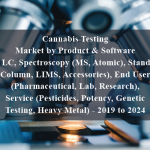OVERVIEW
The Human Liver Models Market is currently valued at USD 0.3 billion in 2024 and will be growing at a CAGR of 10.98% over the forecast period to reach an estimated USD 0.46 billion in revenue in 2029. The human liver models market is witnessing notable growth propelled by the rising demand for innovative tools in drug development and personalized medicine. These models, ranging from simple 2D cell cultures to complex organoids and microfluidic systems, replicate key aspects of liver physiology and function. With drug-induced liver injury being a major concern in pharmaceutical research, these models offer a means to predict toxicity more accurately and efficiently compared to traditional animal testing methods. Moreover, advancements in tissue engineering and biomaterials have enabled the development of more physiologically relevant liver models, enhancing their utility in studying liver diseases, drug metabolism, and the efficacy of novel therapeutics. As the pharmaceutical industry continues to seek safer and more effective drug candidates, the human liver models market is poised for further expansion, driven by the imperative for reliable preclinical testing platforms.
The increasing focus on reducing reliance on animal models in drug development due to ethical concerns and regulatory pressures is a significant driver. Human liver models offer a more accurate and relevant alternative for preclinical drug testing, aiding in the prediction of drug efficacy and toxicity. Secondly, the rising incidence of liver diseases, including hepatitis, cirrhosis, and liver cancer, has heightened the demand for better research tools to understand disease mechanisms and develop effective treatments. Human liver models provide researchers with a platform to study disease pathology and test potential therapies in a controlled environment. Additionally, the growing trend towards personalized medicine necessitates the development of models that can recapitulate patient-specific responses to drugs and treatments. Human liver models, particularly those derived from induced pluripotent stem cells or patient-derived tissues, hold promise for personalized drug screening and treatment optimization. Furthermore, advancements in tissue engineering, microfluidics, and biomaterials are driving innovation in liver model development, leading to the creation of more physiologically relevant and functional models.
Market Dynamics
Drivers:
The increasing focus on reducing reliance on animal models in drug development due to ethical concerns and regulatory pressures is a significant driver. Human liver models offer a more accurate and relevant alternative for preclinical drug testing, aiding in the prediction of drug efficacy and toxicity. Secondly, the rising incidence of liver diseases, including hepatitis, cirrhosis, and liver cancer, has heightened the demand for better research tools to understand disease mechanisms and develop effective treatments. Human liver models provide researchers with a platform to study disease pathology and test potential therapies in a controlled environment. Additionally, the growing trend towards personalized medicine necessitates the development of models that can recapitulate patient-specific responses to drugs and treatments. Human liver models, particularly those derived from induced pluripotent stem cells or patient-derived tissues, hold promise for personalized drug screening and treatment optimization. Furthermore, advancements in tissue engineering, microfluidics, and biomaterials are driving innovation in liver model development, leading to the creation of more physiologically relevant and functional models.
Key Opportunities :
He human liver models market presents several key opportunities for growth and innovation. Firstly, there is immense potential for the development of more sophisticated and physiologically relevant liver models that can better mimic the complexity of the human liver microenvironment. Advancements in tissue engineering, 3D bioprinting, and organ-on-a-chip technology offer avenues for creating more accurate models with enhanced predictive capabilities for drug toxicity testing and disease modeling. Additionally, there is a growing demand for personalized medicine approaches, opening opportunities for the use of patient-derived liver cells or induced pluripotent stem cells to create customized liver models for drug screening and treatment optimization. Moreover, the expansion of research into non-alcoholic fatty liver disease (NAFLD), liver fibrosis, and other liver pathologies presents opportunities for the development of specialized models tailored to these areas of study. Furthermore, collaborations between academia, industry, and regulatory agencies can foster the standardization and validation of liver models, accelerating their adoption in drug development and regulatory testing.
Restraints :
One significant challenge is the complexity of replicating the intricate structure and functions of the human liver in vitro. While advancements have been made in developing more sophisticated models, achieving full physiological relevance remains elusive. Additionally, the high cost and technical expertise required for the development and maintenance of these models pose a barrier to widespread adoption, particularly for smaller research institutions and biotech startups. Furthermore, regulatory uncertainties surrounding the acceptance and validation of liver models for drug testing purposes present another restraint. Standardization and validation protocols need to be established to ensure the reliability and reproducibility of results obtained from these models. Moreover, ethical considerations related to the use of human cells and tissues in research could also limit the availability and use of certain types of liver models. Addressing these restraints will be crucial for unlocking the full potential of human liver models in advancing drug discovery, disease research, and personalized medicine.
Regional Information:
• In North America, the human liver models market is buoyed by robust research infrastructure, significant investments in biomedical research, and a strong emphasis on technological innovation. The presence of leading pharmaceutical and biotechnology companies, coupled with favorable regulatory frameworks, drives the adoption of advanced liver models for drug discovery and toxicology studies. Additionally, increasing collaborations between academia and industry further propel market growth, fostering the development of novel liver models and their applications across a wide range of research areas.
• In Europe, the human liver models market benefits from a rich scientific landscape, with renowned academic institutions and research organizations driving innovation in liver disease research and drug development. The region’s stringent regulatory environment underscores the importance of reliable and predictive preclinical models for drug safety assessment, spurring demand for advanced liver models. Furthermore, initiatives such as the European Union’s Horizon 2020 program incentivize collaborative research efforts, facilitating the development and commercialization of next-generation liver models with enhanced physiological relevance and predictive capabilities.
• In the Asia Pacific region, the human liver models market is witnessing rapid growth propelled by expanding pharmaceutical and biotechnology sectors, increasing investment in research and development, and a growing focus on precision medicine. Countries like China, Japan, and South Korea are emerging as key players in liver disease research, driving demand for innovative liver models to support drug discovery and personalized medicine initiatives. Moreover, the availability of cost-effective research solutions and a large pool of skilled researchers contribute to the region’s attractiveness as a hub for liver model development and commercialization.
Recent Developments:
• September 2023: UC Davis Health launched a new adult liver transplant program. The move expands the existing services of the UC Devis Transplant Center and provides comprehensive care to patients with liver disease.
• April 2022: CN Bio, an organ-on-chip (OoC) company, launched PhysioMimix’in-a-box’ liver OoCreagent kit for non-alcoholic steatohepatitis (NASH)-a disease that, to date, has no regulatory-approved therapeutics for treatment because of the inability to predict human responses to this complex disease via traditional in-vivo animal studies.
Key Market Players:
InSphero AG, Organovo Holdings, Inc., CN Bio Innovations Limited, Emulate, Inc., Hµrel Corporation, Advance Biotechnology, Inc., Hepregen Corporation, Kirkstall Ltd., Mimetas B.V., and Nortis, Inc.
Frequently Asked Questions
1) What is the projected market value of the Human Liver Models Market?
– The Human Liver Models Market is expected to reach an estimated value of USD 0.46 billion in revenue by 2029.
2) What is the estimated CAGR of the Human Liver Models Market over the 2024 to 2029 forecast period?
– The CAGR is estimated to be 10.98% for the Human Liver Models Market over the 2024 to 2029.
3) Who are the key players in the Human Liver Models Market?
– InSphero AG, Organovo Holdings, Inc., CN Bio Innovations Limited, Emulate, Inc., Hµrel Corporation, Advance Biotechnology, Inc., Hepregen Corporation, Kirkstall Ltd., Mimetas B.V., and Nortis, Inc.
4) What are the drivers for the Human Liver Models Market?
– The shift towards human liver models in drug development is driven by ethical concerns and regulatory pressures. These models provide accurate, relevant alternatives for preclinical testing, aiding in drug efficacy and toxicity prediction. The rise in liver diseases necessitates better research tools for disease mechanisms and treatments. Advancements in tissue engineering, microfluidics, and biomaterials are driving innovation in liver model development.
5) What are the restraints and challenges in the Human Liver Models Market?
– The complexity of replicating the human liver in vitro remains a challenge, with high costs, technical expertise, regulatory uncertainties, and ethical considerations limiting widespread adoption. Standardization and validation protocols are needed to ensure reliability and reproducibility, while ethical considerations may limit the availability of certain types of liver models. Addressing these restraints is crucial for drug discovery, disease research, and personalized medicine.
6) What are the key applications and offerings of the Human Liver Models Market?
– Human liver models find key applications in drug discovery and development, enabling more accurate prediction of drug efficacy and toxicity. They are invaluable tools for studying liver diseases such as hepatitis, cirrhosis, and liver cancer, aiding in understanding disease mechanisms and developing targeted therapies. Additionally, liver models play a crucial role in personalized medicine by facilitating the testing of patient-specific drug responses and treatment optimization. Furthermore, they are utilized in toxicology studies to assess the safety profile of pharmaceutical compounds and environmental toxins, contributing to improved drug safety assessment and regulatory compliance.
7) Which region is expected to drive the market for the forecast period?
– North America is expected to have the highest market growth from 2024 to 2029
Why Choose Us?
Insights into Market Trends: Global Market Studies reports provide valuable insights into market trends, including market size, segmentation, growth drivers, and market dynamics. This information helps clients make strategic decisions, such as product development, market positioning, and marketing strategies.
Competitor Analysis: Our reports provide detailed information about competitors, including their market share, product offerings, pricing, and competitive strategies. This data can be used to inform competitive strategies and to identify opportunities for growth and expansion.
Industry Forecasts: Our reports provide industry forecasts, which will inform your business strategies, such as investment decisions, production planning, and workforce planning. These forecasts can help you to prepare for future trends and to take advantage of growth opportunities.
Access to Industry Experts: Our solutions include contributions from industry experts, including analysts, consultants, and subject matter experts. This access to expert insights can be valuable for you to understand the market.
Time and Cost Savings: Our team at Global Market Studies can save you time and reduce the cost of conducting market research by providing comprehensive and up-to-date information in a single report, avoiding the need for additional market research efforts.












